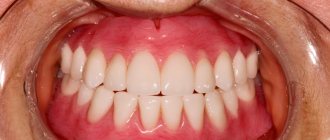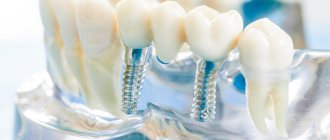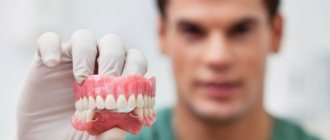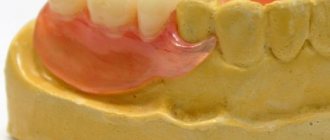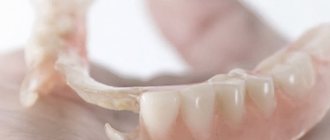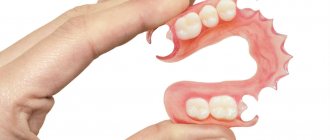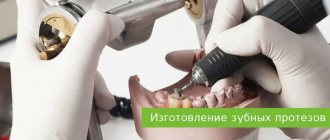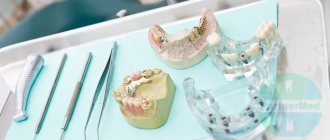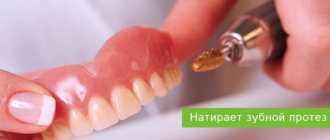The loss of even one tooth in a row can lead to serious negative consequences for the health of the oral cavity as a whole, so it is necessary to solve the problem and restore lost dental units immediately. To restore lost teeth, modern dentistry offers different types of procedures - prosthetics and implantation. The greatest demand among patients is for more affordable prosthetics, which can involve both fixed and removable types of dentures.
In terms of durability and strength of fixation, the best option would be fixed dentures, but their installation is not always possible, and then removable dentures can help restore the beauty of your smile. However, such orthodontic structures are available in a wide range, and sometimes the patient finds it difficult to choose a specific type of product for prosthetics. This article is designed to help you find out all the useful details about removable dentures, and we will start with a detailed overview of all existing types of removable dentures.
Removable dentures: definition and classification
Orthodontic products for prosthetics can be either removable or non-removable. The key difference between the designs is that by choosing a removable denture, you can always either remove or put it on without the help of a specialist. Removable dentures have their own gradation into individual varieties, which is important to get acquainted with - this will help you make the right choice of a specific type of product. First of all, you should know that there are separate types of removable dentures for complete and single restoration.
Dentures made in Moscow on the same day of treatment
We can restore the beauty of your smile in a matter of hours by making a new denture in a day or repairing an old one. Urgent production of dentures is in demand and allows the patient not to feel any discomfort, both physical and psychological, for a minute. A team of professionals is at your service - one of the best in Moscow and Russia. Dentures can be made in Moscow in one day in our own modern laboratory, equipped with the best equipment. This includes a pre-planning technique that allows you to visualize the treatment result.
Dentures for restoration with complete edentia
Complete restoration of the dentition is necessary when all teeth have been lost and a complete removable denture is used for it, which allows you to effectively solve the problem of tooth loss, but keep in mind that such designs do not differ in reliability and long useful life, and especially the so-called soft orthodontic products - from plastic or nylon.
The rapid wear of the prosthesis is explained by the fact that with a complete restoration it is not possible to achieve coordinated work of the masticatory muscles: the main pressure will be exerted on the mucous and gingival part of the oral cavity and cause a decrease in the natural volume of the tissues of the jaw joint. As a result of this effect, the height of the gums will gradually decrease, and this process will ultimately lead to the fact that the old prosthesis simply will not stay on the installation bed. Moreover, the incorrect position of the removable denture in the mouth will provoke manifestations of pain when eating or actively talking.
Full removable orthodontic products are not the best option for restoring lost teeth because they cannot be properly fixed in the oral cavity and, especially, in the lower jaw area. Even the use of special adhesive gels will not give you a guarantee that the removable denture will not fall out of its place at the most inopportune moment. In such cases, dentists advise not to save money and initially carry out restoration with removable dentures on implants, which we will discuss in detail below.
USEFUL FACT: Removable dentures do not stop the process of bone tissue atrophy and, on the contrary, accelerate its progress. As the bone volume decreases, the denture will no longer stay in place and will require replacement. This is another reason why it is recommended to replace a removable orthopedic structure with a non-removable product as quickly as possible.
Author: Christian E. Besimo, Dr. Med. Dent. (outside lecturer) Hans-Peter Rohner, Master Dental Technician Translation: Ukhanov M.M. - dentist, Moscow The original text is on the website www.cmsa.ch SUMMARY For the manufacture of implant-supported dentures, edentulous elderly patients require a wide range of treatment techniques from a medical and socio-economic point of view. Many different efforts can be put into treatment to create an implant-supported prosthesis that meets the needs of a specific patient. Edentulous jaws can be restored not only with the help of fixed bridges and hybrid prostheses, fixed on balls and couplings, magnets or beams, but also on newly introduced superstructures, rigidly fixed on cone-shaped (telescopic*) crowns or factory-made cylindrical attachments. They optimize the range of treatment options available by combining the tissue compatibility, ease of use and esthetics of fixed dentures with the ease of maintenance and repair of removable dentures. Ultimately, prosthetic conditions can be significantly improved, even in cases where only a few teeth remain, by increasing the number of supports on which the attachments fixed to the implants can be placed.
1. Introduction The end of the 20th century is characterized by increasing aging of the population, a process that will continue into the next century, its outcome difficult to predict (1). Dentists should recognize that intensive efforts invested in preventative and restorative dentistry will result in older patients having a large number of remaining teeth (2,3). This will result in a huge increase in the amount of dental treatment required by older patients. Recent studies from Switzerland have shown that the increased number of elderly patients will be offset by the freeing up of dental work capacity due to successful preventive treatment in adolescents and adults (4-6). In the future, increased amounts of caries and periodontal treatment will be required by the elderly population. Consequently, fixed or removable dentures, including implant-supported complete dentures, will be required more frequently during the later periods of patients' lives—which contain both medical and psychosocial challenges to dental treatment (7–10). As dental care adapts to this evolution, economic aspects must also be taken into account. On the one hand, it is doubtful that the purchasing power of the elderly could undermine the cost of health care, and it is known that pension schemes cannot be guaranteed to be taken into account for a long period. On the other hand, the increasing demand among the elderly for dental care should not be underestimated. Research has shown that in Germany, more than half of senior citizens over 60 years of age prefer to pay for quality when paying for something (11). The concept of orthopedic treatment for the elderly must include various types of treatment in order to produce the necessary prosthesis that suits the patient's individual situation, medical and psychosocial conditions, economic situation, and also possible future changes. Edentulous patients can only be provided with implant-supported dentures when the wide range of treatment options available includes fixed bridges and removable superstructures. When edentulous jaws are replaced with prosthetics, not only hybrid prostheses fixed on balls and couplings, magnets or beams can be used, but also superstructures rigidly fixed using cone-shaped crowns or ready-made cylindrical attachments. In this way, they optimize treatment options and combine the tissue compatibility, ease of use, and esthetics of fixed prostheses with the ease of maintenance and repair of removable dentures (12). This article presents a practical approach to a treatment concept complemented by a new superstructure for removable dentures in edentulous mandibles. Dentures are usually fixed using ready-made attachments. 2. Treatment concepts that include removable superstructures 2.1 Hybrid prostheses fixed to two implants using ball and sleeve clasps. Two ball-and-socket locking implants are a simple and cost-effective method of securing existing or new complete dentures (13–15). The prosthesis can function well only on balls and couplings if the implants are installed in such a way as to fix it correctly and prevent traumatic tipping and rocking of the prosthesis. The transversal rotation axis, defined by ball and sleeve locks, should be located as far as possible in relation to the anterior region. In addition, the two implants must be installed so as to create a reference line of the required length to prevent rotation of the prosthesis around the sagittal axis (12,16) (Fig. 1). Experiments with a ball-and-sleeve clasp supported by a single implant placed in the midline of the edentulous mandible have shown promising initial results (17). However, whether prosthetic fixation will be achieved with such a minimal amount of treatment depends largely on the characteristics and extent of the hard and soft tissues around the alveolar ridges.
Ball-and-sleeve clasps on two implants are particularly indicated for stabilizing existing complete dentures in elderly patients with limited ability to tolerate stress and questionable ability to adapt to a new denture. Ball and coupling locks are preferable to beams with a round or ovoid cross-section because single attachments require less space. Provided that the correct prosthetic plan is completed, a ball and socket lock can often be installed directly in the patient's mouth without additional reinforcement of the prosthesis or changes in its external contours. When using this technique, the patient fixes his existing prosthesis, which the central nervous system perceives sensory and the need for adaptation to the new situation is questionable (12). Magnets are also a simple method for fixing dentures. However, these attachments often require more space than ball and sleeve locks and their locking forces cannot be adjusted. In addition, magnets do not stabilize the prosthesis against horizontal, shearing forces. As a result, this leads to insufficient fixation of the prosthesis. Finally, due to the mobility of the prosthesis, the magnets are subject to relatively high abrasion (13–15).
In addition to ball and sleeve locks supplied by various implant manufacturers, which are all mounted axially or centrally on the implant, other types of attachments may also be used. They are either soldered or, better yet, laser welded to special implant abutments, which are described together with cylindrical attachments in the following text (12). Ball and sleeve locks can be installed on the abutment to match the contours and direction of application of the removable denture. The male part of such locks (for example Dalbo-Classic, CENDRES&METAUX SA, Biel, Switzerland) is a ball, and the matrix part is a sleeve-shaped coupling that can be adjusted (Fig. 2). Matrices with plates are preferable to those with ring springs, because they cause less abrasion on the patrix and are more easily adjusted or deactivated using special tools (18) (Fig. 3). Ball and coupling locks made from gold alloys or titanium are now available in the market. Titanium attachments with screwed or welded male parts are preferred for implant-supported restorations. The matrix parts are adhesively fixed in the base of the removable denture.
The spherical patrix (1) and the sleeve-shaped matrix (2) are made of an alloy with a high gold content. The PVC ring (3) protects against penetration of plastic into the gap between the plate and the matrix part fixed in the base of the removable denture. Visible surface abrasion is caused by the circular ring after 104 working cycles in vitro. 2.2 Hybrid prosthesis with a bar attachment supported by three or four implants. Splinted with a fixed bar, more than 2 implants hold the removable denture firmly and truly rigidly (19) (Fig. 4). Especially in the case of an arched anterior mandible, this provides greater stability of the prosthesis compared to the combined retention that can be achieved with two ball and sleeve clasps. Prosthetics for defect replacement are an important indication for implant-supported bars (12). Jaw defects can also be restored with single-section bridges. In addition, the cantilever extension can be supplemented with a bar so that the prosthesis is supported only by implants, which can be very beneficial for patients with defects. The use of this method for the prevention of atrophy in the edentulous parts of the jaw without implants is also currently being discussed (20,21). However, clinical results indicate that the increased fractures were possibly caused by the close proximity of the beam extension (22).
The large amount of space required for beams is often a problem in clinical use. Although this problem can be mitigated by the use of small, off-the-shelf components, the labor-produced, reinforcing framework is often fabricated with an anatomically shaped backplate for the removable denture. Due to technical and economic considerations, a new prosthesis is usually required in such cases. Making a removable denture and fitting beam sections to each other complicates technical manipulations. Prosthesis maintenance procedures, such as relining or replacing a defective socket, are even more complex than for single attachments. Due to the fact that complex soft tissue diseases often occur in atrophied edentulous jaws, the use of conical crowns or cylindrical attachments to optimize the shape of the prosthesis should be taken into account - this technique requires the same or less amount of effort (12).
The use of factory-made standard beams made of titanium or precious alloys is also possible. Matrix parts (for example Dolder beam attachment, CENDRES&METAUX SA) are made from cold-processed wire in the form of a rectangle with an occlusally rounded cross-section. The beam of the required length is cut from the wire and soldered or, even better, welded to a factory-made superstructure made of the same material as the implant system. The matrix parts consist of sleeves and retainers, and must be held in place using plastic. Same here, single sections can be cut from a longer piece - the cuts should be made between the welds that connect the sleeve and the retainer. The matrices are adjusted and deactivated with special tools (Fig. 5).
3 Superstructures with conical crowns or cylindrical locks supported by 3 or 4 implants.
Splinting three or four implants with removable conical crowns or prefabricated cylindrical clasps increases the design of the conventional superstructure of a hybrid prosthesis for the edentulous mandible. The peri-implant section of a removable denture can be designed similarly to a bridge. Saddles resting on the gum are placed only in the posterior areas of the alveolar process (Fig. 6). This type of prosthesis takes into account the unfavorable conditions of the soft tissues, which today often require treatment in cases of severely atrophied, edentulous mandible. Irritation of the peri-implant mucosa, which is often observed under a tight-fitting denture base, can be virtually eliminated. The open design of the denture base minimizes peri-implant plaque and infection caused by the denture. Because The removable denture base is designed like a bridge, this helps to ensure oral hygiene for elderly patients, for whom this is often a problem due to the aging process (Fig. 7). Incorrectly positioned implants or implant axes, which in cases of severe atrophy are often unattainable despite precise planning, can essentially be compensated for by small prefabricated cylindrical locks (Fig. 8).
Using this method, the superstructure remains properly contoured. (12.23). Superstructures with four conical crowns or cylindrical locks can be designed as implant-supported removable bridges if there is enough bone to accommodate two implants on each side of the mental foramen. In cases with few remaining or unfavorably positioned teeth, prosthetic conditions can be significantly improved by increasing the number of implants, such as implant-supported anchorages (24) (Fig. 9).
Periotests on mandibular models have shown that conical crowns supported by four implants transfer loads to the implant abutments comparable to those transmitted by a bar-supported prosthesis (25). This was confirmed by assessing implant excursions on a mandibular model using laser holography and recording the load in the patients' oral cavity (27). The results of these studies do not indicate that one of the retention systems studied exhibits specific deficiencies. A comparative, extreme, elementary analysis of fixed and removable splinting of two implants shows that in two and three-dimensional models, single attachments distribute the load more uniformly than articulated bar-supported restorations (28,29). These results and clinical experience confirm, from a functional point of view, the concept of peri-implant and aesthetic optimization of removable superstructures by splinting implants using attachments. Continued long-term clinical studies are needed to discover possible differences between the retention systems of implant-supported dentures discussed in this article. 3. Design and production of suprastructures with ready-made cylindrical locks. The use of ready-made cylindrical locks greatly simplifies clinical and laboratory manipulation of removable superstructures compared to bars and individually manufactured conical crowns. As previously mentioned, due to the minimal dimensions of the attachment, even if the preoperative conditions are unfavorable for prosthetics, it has a higher “flexibility” during the construction of the bridge restoration (Fig. 8). In addition, special ancillary instruments and replaceable components simplify long-term patient care of the prosthesis (12,24). Because Completely prefabricated, conical crowns (30) on implants require additional space and do not achieve results comparable to those obtained with superstructures supported by custom-made conical crowns or cylindrical locks. 3.1 Manufacturing a primary lock using the modulating principle.
Ready-made cylindrical locks consist of a cylindrical male part and a sleeve-shaped matrix part - in fact, they are standard telescopic crowns. The outer cylinder is secured to the inner cylinder by a combination of friction and clamping, or by the use of active locking devices. The male part is either soldered or, better yet, laser welded into place. The matrix part is fixed in a removable denture. These locking devices are easily fitted, adjusted and replaced using tools supplied by the manufacturer for bench and laboratory use. Conod, Dalbo - Z and Mini-Gerber (CENDRES&METAUX SA) (12,13) have been proving their value in clinical use on implants for a relatively long time.
Some implant systems include special abutments with solder-weld components that facilitate the fitting of standard single attachments. These abutments contain an axial fixation screw, titanium intermediate rings, which come in different heights. The height of the ring should be selected in accordance with the thickness of the peri-implant soft tissues. The intermediate ring is a connecting clip that secures the genuine high-gold alloy abutment (Fig. 10). It must be tightened using a special coupling tool. The smooth cylindrical part can be ground down in order to modify it. This allows several cylindrical attachments on implants to be made parallel and incorrectly placed abutments to be aligned. The peripheral milled shoulder in the cylindrical part of the abutment improves the stability between the connecting clamp and the fixed part of the frame, and increases the space available for the design of a removable denture, as far as the soft tissue allows. Now it is possible to use cylindrical locks made of pure titanium, which can be mounted on implants. Titanium abutments and prototype Mini-Gerber PLUS cylindrical locks, which include titanium matrix and male parts, are currently undergoing clinical trials. The buttments resting on the implants and the cylindrical locks are connected by laser welding (12) (Fig. 11 and 12).
3.2. Removable denture During the restorative phase, the teeth must be set and fitted in the patient's mouth in order to form the basis for the manufacture of the primary clasps and removable frame. The dental technician should use a silicone fitting key adjusted in the patient's mouth to transfer the tooth alignment to the final denture (Fig. 13).
The peri-implant part of the removable frame is modeled like a bridge with saddles that can be repositioned (Fig. 14). The framework must be cast from titanium or cobalt-chrome, and the matrix parts of the clasps are adhesively fixed in the patient's mouth to ensure their completely passive application (12). For more perfect fit accuracy, silicone or zinc oxide eugenol impressions, once already fitted with the frame, should make the plastic base fit to the repositioned clamps. The bridge portion should be veneered with chemically/light-hardening plastic denture teeth. Special color effects can be added using paints mixed individually for the patient (Fig. 15). In cases with complex function and aesthetics, the superstructure should be tried again before final polishing.
4. Conclusion This article has confirmed that removable superstructures with different types of fixation allow the fabrication of a complete removable, implant-supported mandibular prosthesis that meets the specific needs and desires of elderly patients. This innovative addition to conventional hybrid suprastructures with conical crowns or prefabricated cylindrical locks takes into account the unfavorable soft tissue conditions often encountered in cases of severe jaw atrophy. Improving the function of the prosthesis in cases with several remaining or unfavorably located teeth can be achieved by installing additional implants on which single attachments can be installed. The use of standard cylinder locks and the clinical/laboratory procedures demonstrated in this article are significantly easier than the fabrication of custom conical crowns and bar-supported restorations. Bibliography
Removable dentures for partial dentures
If the patient has preserved teeth in the rows and these units are absolutely healthy, for restoration it is optimal to select one of the existing types of removable orthodontic systems for partial dentures.
In partial prosthetics, dentists use structures equipped with a special type of fastener - clasps. At their core, clasps are miniature locks that are attached to the jaw. The elements are made from fairly strong metal wire, which guarantees reliable fixation of the removable denture.
It is important to understand that partial dentures are only possible if there are units in the dentition that can be used as support for the installation of a removable denture. Another important nuance that must be taken into account when selecting a prosthesis for restoration with a single edentia is that not all types of structures are aesthetic in appearance and therefore they are not recommended for installation in the smile area.
Classification of removable dentures in dentistry is also carried out according to the material of their production. The material used to make an orthodontic product is one of the key criteria for the proper selection of a removable denture, since such important indicators as the comfort of use of the structure, its reliability and durability depend on it. Below we will consider in detail all types of removable dentures based on the material used.
Which clasp dentures are better for teeth?
Frankly, it is impossible to compare designs with each other and determine which clasp dentures are better for teeth. For the most part, patients consider this type of prosthetics as temporary before implantation. They are left as permanent ones by those who cannot afford alternative methods.
Each type of clasp dentures has its own advantages, indications and contraindications and is recommended in strictly defined cases after studying the clinical picture. The main thing that patients need to know is that even the best orthopedic structures can cause harm if they are improperly manufactured or installed. Turning to inexperienced and incompetent dentists can result in the following troubles:
- breakdown of supporting units (most often within several months after installation of the prosthesis);
- a pathological bite is formed;
- possible deformation of the temporomandibular joint;
- the speed and intensity of tooth abrasion increases;
- complex diction disorders appear that do not go away over time.
An experienced orthopedic dentist can tell you which clasp dentures are best for your teeth.
Plastic or acrylic removable dentures
Acrylic or plastic removable dentures are inexpensive and easy to manufacture and use. For their production, a special type of acrylic plastic is used, characterized by increased characteristics of strength, hygiene and hypoallergenicity. The product is fixed to the jaw with soft valves, which are more colloquially referred to as “suction cups”. Naturally, the quality of fixation leaves much to be desired - the soft fastening element does not ensure reliable adhesion of the structure and tissues of the oral cavity.
If you have chosen a removable prosthesis with valves, be sure to make sure of the quality of its manufacture. This can be done using a simple test: having installed the denture in your mouth, try to bite something with it. If you feel air escaping from under the removable denture, it means it is made with high quality and will be comfortable to use.
An acrylic prosthesis will not cause pain during use if its base fits tightly to the gums. Otherwise, the chewing load will be placed on the soft tissues, which will cause a process of gradual atrophy and then deformation of the orthodontic structure itself.
Expert advice: Order the production of an acrylic removable denture with an individual impression tray - this will guarantee a tight fit of the structure to the tissues of the jaw and ensure its most reliable fixation on the jaw.
The advantages of removable acrylic dentures include the following qualities:
- The design is manufactured quickly and simply, which makes its cost as affordable as possible for patients.
- Acrylic removable dentures are easily repaired and restored if broken or damaged.
However, acrylic products also have a number of disadvantages, which are important to study before choosing this type of removable dentures. Professionals call the main disadvantage of plastic structures the fact that when installed in the oral cavity, the base of a removable denture will block the palate and this often causes such undesirable consequences as diction disorders and a decrease in the natural sensitivity of taste buds.
Removable acrylic dentures cannot be used for prosthetics in the lower jaw area, since there is no way to firmly fix the structure on the gums. Without reliable fixation, there is a risk that the prosthesis will fall out during eating or active dialogue. Inexpensive removable dentures made of acrylic do not differ in durability. The product will have to be replaced with a new one every two to three years, since plastic is a material prone to deformation. The useful life of a removable acrylic prosthesis may be shorter in situations where the process of reducing the volume of bone tissue in a patient occurs at an accelerated pace.
If we talk about the exact cost of the service for the manufacture and installation of a plastic prosthesis, it will depend on the type of product and the need for additional procedures before prosthetics. You can get a detailed consultation on removable prosthetics at any time convenient for you at our dentistry in Moscow - VENSTOM (located next to the Baumanskaya metro station).
Possible complications after dental prosthetics
If you choose the right clinic with qualified specialists, the risk of complications is minimal. But complications are sometimes associated not with medical errors, but with the characteristics of the dental tissues and the general health of the patient. Therefore, it is impossible to completely exclude them. Main causes of complications:
- incorrect choice of prosthesis design and material for its manufacture;
- untreated infectious and inflammatory processes in the oral cavity;
- violation of the technology of individual stages of prosthetics;
- patient's failure to comply with oral hygiene;
- the patient has common diseases that reduce immunity - diabetes, etc.
Types of complications:
- Infectious and inflammatory processes of the gums and oral mucosa (gingivitis, periodontitis, stomatitis) due to rubbing of soft tissues by the prosthesis or compression of blood vessels and nerves; if the problem cannot be resolved with antibacterial therapy, the prosthesis is removed, the pathology is treated and prosthetics are re-placed.
- Secondary caries – develops in supporting teeth under crowns; Thorough daily oral hygiene and professional teeth cleaning twice a year will help.
- Allergy to dental material – severe swelling of the mucous membrane, headache; requires immediate removal of the prosthesis, treatment and subsequent re-prosthetics using a product made of a different material.
- Destruction of the prosthesis - chips, cracks, etc. - can occur when eating hard food, hitting the jaw area, etc.; a small chip can be eliminated using modern filling materials; but if the product is completely destroyed, it must be replaced.
- Crowns that are too high or low - the chewing process and the load on the jaw tissue are disrupted; replacement of the prosthesis is necessary.
- A denture has fallen out - you need to save the fallen product and urgently contact a dentist.
Moderate pain after prosthetics is normal. They are associated with the adaptation of tissues to new designs and pass over time. But if the pain increases and is accompanied by swelling and redness of the tissues, you need to consult a doctor.
Signs of denture rejection
Sometimes (very rarely) rejection of the implant root occurs - the titanium root (the basis of the prosthesis) for some reason does not take root in the patient’s tissues. This can happen either one or two days after implantation, or much later. More often, implants do not take root in smokers and in patients who do not maintain oral hygiene. Signs:
- the gums bleed for a long time (more than three days);
- body temperature rises, it may not be high, but it can rise to significant numbers;
- moderate pain, which normally appears after implantation, sharply intensifies and becomes acute;
- the gum and adjacent cheek swell;
- after some time, pus appears from the gums;
- there will be a feeling of weakness, weakness, headache;
- the titanium root and the prosthesis installed on it can become mobile and even fall out of the gums.
If such symptoms appear, you should immediately contact your dentist.
Removable dentures made of nylon in Moscow
Another budget option for orthodontic structures for removable prosthetics are removable nylon dentures. Already from the name of the products it is clear that they are made from nylon - a soft polyamide with increased elasticity. This type of construction is applicable in both complete and single prosthetics. In the production of removable dentures, biocompatible and hypoallergenic nylon is used, which does not change color and properties under the influence of various external aggressive factors.
Dental nylon has a non-porous structure, which prevents the penetration of pathogenic microorganisms into the prosthesis. This quality distinguishes removable nylon dentures from products made of acrylic and other types of plastic. Nylon structures are fixed to the gums, where the base of the removable denture is fixed with special locks. Fastening elements are also made of nylon (less commonly, silicone) and therefore they remain inconspicuous against the background of the natural tissues of the oral cavity. Nylon clasps help to obtain the tightest possible fit of the removable denture to the bed, which is necessary for reliable fixation of the product in the mouth.
Among the advantages of removable dentures made of nylon are the comfortable anatomical shape of the products, compact size and low weight. These characteristics facilitate the process of adaptation to the design and reduce the risk of pain during the use of a removable denture. But orthodontic products made of nylon have not only advantages, but also a significant number of disadvantages:
1. A removable nylon denture does not provide coordinated work of the masticatory muscles and therefore excessive pressure occurs in the oral cavity on the soft tissues and mucous membranes. Constant loads on soft tissues and jaws accelerate the process of receding gums and reducing the volume of bone tissue.
2. Increased flexibility of the design leads to the fact that some of its elements will work more when chewing food, while others will work less. The result of uneven load is the patient’s discomfort while eating and fairly rapid wear of the removable denture.
3. Over time, the removable nylon denture sags and this phenomenon is fraught with inflammation in the oral cavity.
4. The surface of the product is rough and therefore plaque accumulates on the prosthesis, stone is formed, and an unpleasant odor may appear from the mouth.
Also, the disadvantages of removable dentures made of nylon include the significant time consumption for manufacturing the structure and the need for frequent and regular visits to the dentist for hygienic procedures to sanitize the denture base and the oral cavity.
Which removable dentures are better – acrylic or nylon? Comparison of designs and reviews from experts
What type of dentures is better - nylon or acrylic? Patients often turn to dentists with this question, finding it difficult to make a choice on their own. The answer to this pressing question will depend on in which area of the oral cavity restoration is required and what kind of restoration it will be - complete or partial.
If it is necessary to carry out prosthetics with complete edentia, then it is more advisable to opt for acrylic removable dentures - they stay in the oral cavity better due to the “suction cup” effect. But nylon and acrylic removable dentures are equally poorly suited for restoration in the area of the lower jaw bone - the products simply cannot be firmly fixed in this area. Therefore, here it is best to consider a fundamentally different type of structure - clasp dentures or dentures on implants. Nylon prostheses are inferior to plastic structures in terms of ease of use and durability. When using them, patients are more often concerned about painful relationships, and the care of a soft polyamide prosthesis requires more complex and specific care.
However, removable dentures made of acrylic are not suitable for the restoration of lost dental units with single prosthetics. The clasps of the prosthesis will be clearly visible, which can cause psychological discomfort to the patient. Therefore, for single dental prosthetics in the smile zone, preference is given to clasp or nylon products. Do you want to know more about plastic and nylon removable dentures and make the right choice of denture design? Sign up for a consultation with specialists at our clinic in Moscow – Vanstom! We are located next to the Baumanskaya metro station!
Types of prostheses by material
Dentures are made from a variety of dental materials. All of them have advantages and disadvantages, indications and contraindications for use. The orthopedic dentist must take all this into account. Basic requirements for materials: strength, biocompatibility with human tissues, lack of toxicity, allergenicity, effects on taste and olfactory receptors. The following types of materials are distinguished:
- metal – used for the manufacture of crowns, inlays, bridges; These are mainly precious metals, their alloys and hypoallergenic types of steel; titanium, as well as a nickel-cobalt alloy, are suitable for the manufacture of clasp dentures;
- zirconium dioxide is the most durable material; it looks beautiful in appearance, so it is used to make crowns of any teeth; The disadvantages include its ability to erase the surface of natural antagonist teeth;
- ceramics (dental porcelain) is a very fragile material in its pure form, so today it is rarely used in its pure form for making crowns and only for the front teeth; Dental materials made from glass ceramics are in great demand; famous world brands: Empress Esthetic (Ivoclar Vivadent, Liechtenstein) - glass ceramics based on lithium disilicate - a hard but quite elastic material, dental prostheses made from which can last a lifetime;
- E-max (Ivoclar Vivadent, Liechtenstein) - glass ceramics based on lithium disilicate; used for the production of crowns, inlays, veneers, bridges of the highest quality - hard, durable and very aesthetic, completely consistent with natural teeth; the crowns are very thin, so the teeth underneath do not require significant grinding;
- Ceramage (SHOFU Dental, Germany) - microceramics based on zirconium silicate;
- acrylic - the advantages of this material include lightness, plasticity, and affordable price; cons – removable acrylic dentures can cause allergies and often break;
You should trust your dentist in choosing the material. He will select the material that is most suitable in terms of properties, quality and price for a particular patient.
Dental dentures “Acry-free”
Innovative removable dentures are “Acry-free” dentures. These are elastic and flexible products made from unique raw materials based on acrylic resin. Acrylic gives the finished structure the necessary strength, rigidity and ensures its durability during operation.
Acri-Free removable dentures are often confused with products made of nylon or plastic, but this is a mistake: the designs have individual quality characteristics and are also easy to restore if the system breaks down. The material for making removable dentures Acry-free is biocompatible with the tissues of the oral cavity and is identical in color to the shade of the gums, which makes the finished structure aesthetic and invisible to others.
Choosing Acri-Free removable dentures is advisable if you have the following indications:
- An individual allergic reaction in a patient to metal alloys and plastic.
- The loss of both one tooth and the complete loss of dental units in rows.
- Periodontitis and periodontal disease. Installing a removable denture for this pathology will help prevent the process of further loosening of the teeth.
- Acri-Free soft prostheses are recommended for people whose professional activities are associated with an increased risk of injury.
Removable dentures of this type are valued by professionals for a significant number of advantages. In particular, the system may be used in prosthetics in cases where the patient has serious gum disease. Acri-Free structures are firmly fixed in the mouth, easy to repair, and the material they are made of does not cause allergic reactions or irritation of sensitive tissues of the oral cavity.
The advantage of Acri-Free is its excellent indicator of the tight fit of the products to the prosthetic bed, which eliminates the manifestation of pain when eating and helps to ensure proper functioning of the masticatory muscles. To install the system, it is not necessary to pre-file healthy teeth, and the prosthesis itself does not sag, does not absorb moisture, and pathogenic bacteria and foreign substances that can stain or damage the product do not penetrate into it. The structures do not require specific and labor-intensive care, their cost is lower than that of nylon removable dentures and, if desired, you can leave the denture on at night.
The only disadvantage of Akri-Free removable dentures is that their constant use will lead to gradual atrophy of bone tissue. But this disadvantage is characteristic of all types of systems used in removable prosthetics.
Rules for caring for dentures
When installing any type of dentures, you must follow the oral care rules recommended by your dentist. They depend on what kind of dental prosthetics was performed. If removable dentures are installed:
- immediately after installing the structure, do not remove it for several days in a row at night, while eating, talking (even if it interferes), until the tissues get used to the pressure exerted on them;
- when the pain and discomfort from wearing the prosthesis go away, it can be removed at night; but modern construction materials make it possible to wear them constantly;
- Every morning and evening after removing the denture, it is washed with cold running water and cleaned with a soft toothbrush and toothpaste without abrasive;
- at night, the prosthesis can be placed in a special protective container or in a container with a disinfectant solution intended for long-term storage; it can be bought at the pharmacy in finished form or in the form of tablets that dissolve in water; clasp dentures with metal parts must be stored in a solution with anti-corrosion properties;
- after each meal, it is advisable to remove the denture and rinse it with water, as well as rinse your mouth;
- Once every six months, the denture can be taken to the dentist for professional cleaning;
- if severe pain, erosion, or inflammatory processes appear in the oral cavity, you should contact a dentist; In this case, it is necessary to install a removable dental prosthesis three hours before the appointment so that the doctor can see exactly what is happening.
Maintenance of the fixed structure:
- In the morning and evening, you need to brush your teeth with toothpaste without abrasive;
- after eating, rinse your mouth with boiled water or mouthwash, and also rinse the interdental spaces with an irrigator;
- It is better not to use dental floss - as a result of their use, the product may be damaged;
- Carry out professional cleaning every six months.
Clasp removable dentures
Prosthetics with clasp dentures are in demand among patients because they allow one to obtain the most reliable and at the same time aesthetic result for the restoration of lost teeth. Structurally, removable dentures are a plastic base with a metal alloy arch on which artificial teeth are attached. The product is fixed to the prosthetic bed with special locks, the type of which is selected based on the characteristics of the case and the preferences of the person requesting the service.
Removable clasp dentures are applicable for both complete and partial restoration and are graded into different types according to the method of fixation:
- Removable dentures with clasps have special hooks made of a metal alloy, which are attached to the supporting teeth.
- Clasp products with attachment. The lock of the prosthesis is hidden inside it and consists of two elements, one of which is attached to the artificial crown, and the second - directly on the tooth of the structure.
- Prostheses with telescopic type crowns.
Clasp dentures can be made from different materials - metal, plastic and metal-ceramics. This makes it possible to choose the best option for different and most complex cases. Clasp-type structures have both pros and cons, which must be studied before making the final decision to install just such a prosthesis. The advantages include the affordability of clasp dentures, aesthetics, no need to remove the product before going to bed, and easy care.
Among the disadvantages of removable clasp dentures, the main one is worth highlighting - the process of adaptation to them is quite lengthy and during it the patient may be bothered by painful sensations. It is also worth considering that the design may be noticeable to prying eyes if prosthetics are performed in the smile area. But as you can see, clasp removable dentures have far fewer disadvantages than advantages, and at the same time, they stay firmly in the oral cavity, ensure proper distribution of the chewing load, and prosthetic constructions can be combined with treatment of teeth and gums.
Immediate dentures
Removable immediate dentures - to replace defects in the dentition during the production of a permanent orthopedic system. There are three types of such models - full, partial, butterfly.
They cope with the task, return partial work to a lost dental unit and hide a visual defect. The disadvantages include fragility, fragility, and long addiction.
Removable dentures without palate
The denture base is made of durable dental alloy, onto which artificial teeth are attached. This product is considered a type of clasp removable dentures, but domestic dentists have also developed “sandwich” dentures, the manufacture of which uses a combination of two materials – acrylic and nylon. Such removable dentures are soft and quite comfortable to use, but at the same time they do not create the necessary and correct distribution of pressure when chewing; the fastening elements of the product look massive and unaesthetic on the teeth.
The gradation of structures is carried out according to the type of fastener:
- Elements in the form of loops. The loops are fixed on the supporting teeth and firmly hold the prosthesis in the installation area.
- Telescopic fastener.
- Attachments. The most reliable and aesthetic option for removable dentures without a palate, but at the same time the most expensive in terms of price.
Pros and cons of dental prosthetics
Various methods of installing dentures have both advantages and disadvantages. But there are more benefits, since orthopedic treatment significantly improves a person’s quality of life.
Advantages
The advantages of prosthetics are obvious. This:
- improvement of appearance; in case of problems with the front teeth, problems of eliminating stress and social adaptation are also solved;
- preservation of jaw bone tissue is a very important function, since when a tooth is absent for a long time in a cell, the bone is resorbed and the dentition shifts, disrupting the function of the dentofacial system;
- correct distribution of the load when chewing;
- elimination of speech defects - dentures in the complete absence of teeth contribute to its restoration;
- prevention of dysfunction of the temporomandibular joint.
Flaws
The disadvantages of installing dentures for teeth are not so noticeable, but they are:
- discomfort in the first days, sometimes the process of getting used to the structure is delayed due to the individual characteristics of the patient’s soft tissues (abrasions and irritation of the gums);
- in some cases, the patient is contraindicated for prosthetics using the method he has chosen and has to choose another method, which does not always suit him for various reasons;
- fixed bridge products require pre-treatment of the supporting teeth and can overload them, leading to loosening;
- improperly installed removable models can place uneven pressure on the jaw, contributing to partial atrophy of its bone;
- a crown or inlay can make root canal treatment difficult for secondary caries.
A good dentist takes into account all the pros and cons, smoothing out the latter and avoiding complications.
Review of the advantages and disadvantages of palateless dentures
The main advantage of removable dentures without a palate is the convenience and safety of the design for the patient. After the restoration procedure, the patient quickly gets used to the installed prosthesis, normal diction is maintained, and there is no unpleasant sensation of strong pressure on the soft tissues of the oral cavity. A removable denture without a palate will ensure optimal distribution of the chewing load and this will reduce the risk of rapid bone tissue atrophy.
There are also disadvantages to removable dentures without a palate. For example, high price. The service for prosthetics with an innovative system will cost more than the installation of plastic or nylon prostheses. It is also worth knowing that for prosthetics with removable dentures without a palate, the presence of supporting teeth is mandatory.
Removable dental prosthetics systems on implants
The opinion of professionals is clear: implant prosthetics is the most modern and reliable solution, both for complete and partial edentia. The result of restoration using implants will not only be as durable as possible, but at the same time aesthetically pleasing and comfortable for the patient.
The procedure for installing removable dentures on implants is a long process and consists of several main stages:
- At the beginning of the restoration process, the oral cavity is prepared for subsequent manipulations. A thorough sanitation of the mouth is performed, and all dental diseases detected during the initial examination are treated.
- Next, the implant is implanted, after which a break is taken in the treatment, which is necessary for adaptation and healing of the damage.
- Crowns are installed and secured.
Removable dentures on implants can be made from different materials, the most budget-friendly of which are acrylic and ceramics. However, the cheaper the material, the more often the prosthesis will have to be changed, while products made from expensive industrial raw materials can last 10 years or more. Removable dentures on implants come in different types and differ both in the type of fasteners and in design - you can order both a single denture and a solid one.
Solid removable dentures on implants can be fixed in the patient’s mouth using different methods:
- Using ball-shaped fasteners. This fixation method is justified when only a few implants are required.
- Using beam fasteners. This installation method is optimal when securing a removable solid denture.
Another method of attaching a removable denture to implants is screw. The use of technology allows for high-quality restoration of the entire dentition, eliminating the need to install an implant on each unit - four implants will be enough to create reliable support for a removable denture. The advantages of the screw fastening method include the precision of fit of the structure on the implant, which ensures optimal distribution of pressure that occurs when chewing food.
Sometimes removable dentures on implants are called conditionally removable. This is explained by the fact that the fixation of the product in the oral cavity will be as strong as possible thanks to the locking system of the design. Such a prosthesis will not fall out when talking or eating and will look aesthetically pleasing and natural. However, the patient can, if necessary, remove the prosthesis at any time.
Prices for restoration with removable dentures on implants are quite high and they depend not only on the pricing policy of a particular dentistry. The full cost of the service will include the cost of preparing for implantation, manufacturing a removable denture, and the price of a specific design from a specific manufacturer. The choice of prosthetic technology will also affect the price of the procedure. But the costs in this case are fully compensated by the excellent and long-lasting results of restoration with removable dentures on implants.
There are a number of contraindications to prosthetics with removable dentures on implants, which you can find out about during a consultation with our dentistry specialists in Moscow - Vanstom. To make an appointment, just call us! We will offer you a full range of removable prosthetics services for complete or partial edentia and pleasant, affordable prices!
Manufacturing and installation of a prosthesis
Includes stages:
- Preparatory and diagnostic – after hygienic cleaning, treatment, the patient undergoes a survey x-ray, CT scan of the jaw, which requires prosthetics.
- The dentist takes an impression and sends it to a dental laboratory.
- The production of an orthopedic system lasts on average 2 weeks. New technologies for taking impressions and 3D modeling make it possible to create anatomically verified structures that reproduce the chewing surface of each element down to the smallest detail.
- The doctor tries on the finished denture for the patient and corrects any discrepancies.
The final stage is fixation of the product in the oral cavity.

